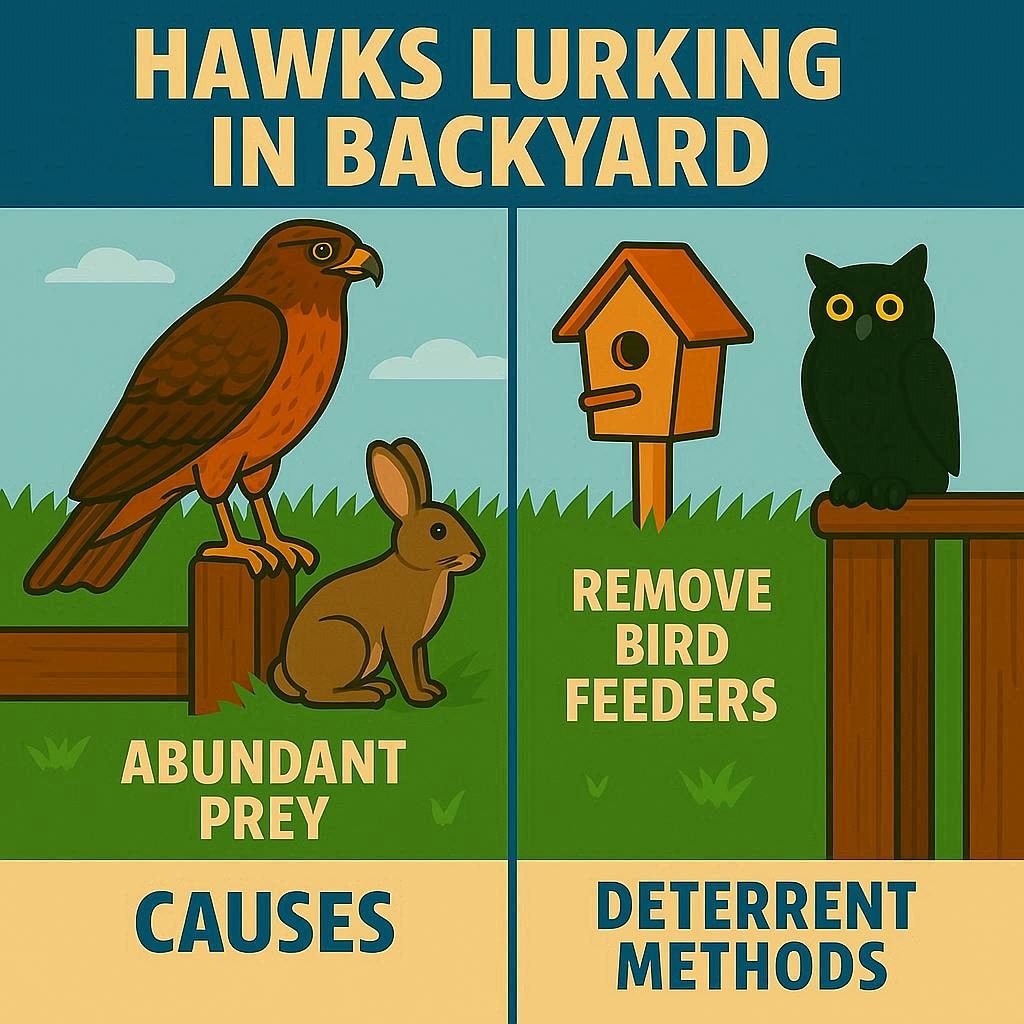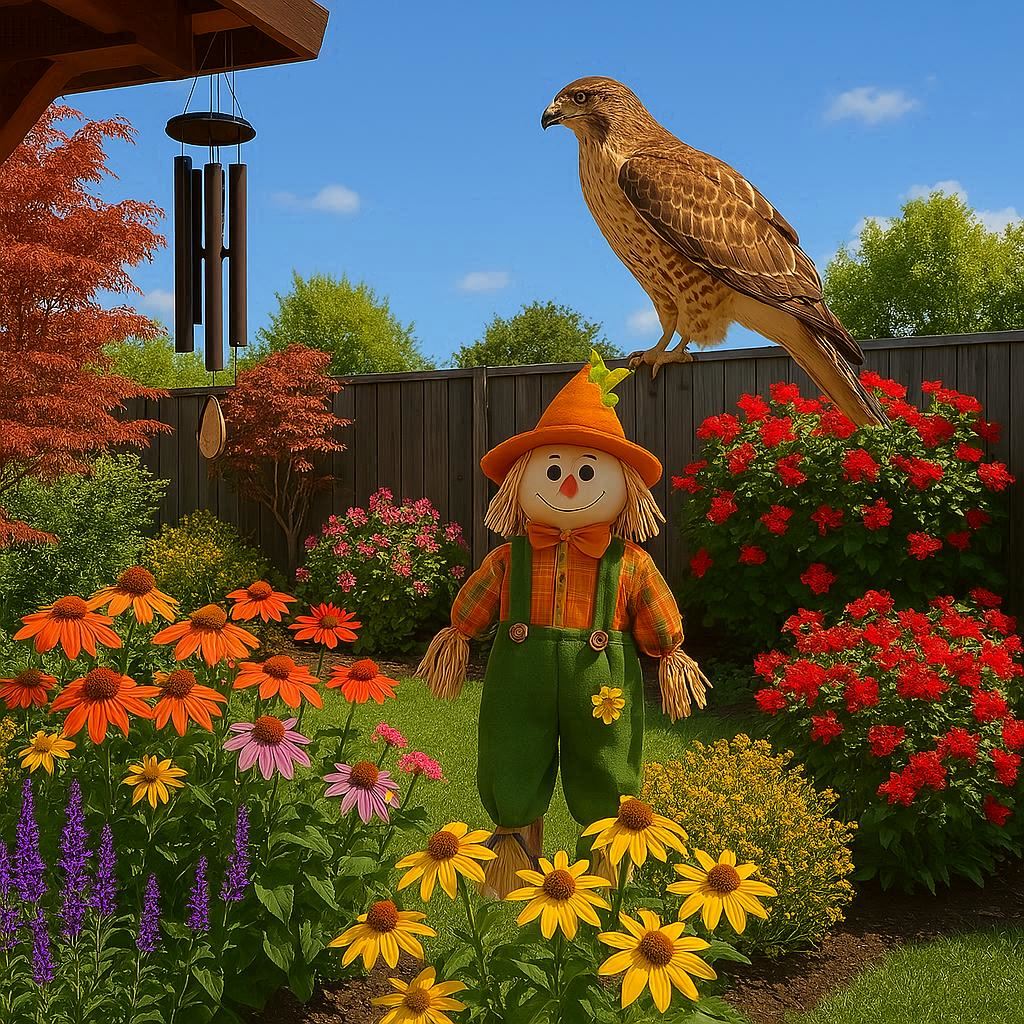
Hawks are majestic birds of prey but their presence in a backyard can be unnerving, especially for those who enjoy watching or feeding smaller birds, or have pets and poultry. This comprehensive article explores the reasons hawks are attracted to yards, the impact they have, and various humane and effective ways to deter and keep them away.
4 Reasons Hawks Are Attracted to Your Backyard
1. Food Availability
Hawks are opportunistic hunters and are largely attracted to yards that provide easy access to prey. This includes:
- Small birds attracted to bird feeders: Concentrations of feeder birds provide a convenient food source.
- Rodents and small mammals: If your yard has a rodent problem, this attracts hawks hunting mice, rats, and voles.
- Rabbits and other small vertebrates: Larger prey like rabbits attract bigger hawks.
2. Shelter and Perching Spots
Hawks prefer yards with mature trees, tall shrubs, and perching sites as vantage points for hunting and resting. These provide good cover to ambush prey or to scan the area.
3. Water Sources
Bird baths, ponds, or other water features attract prey and provide drinking spot for hawks themselves.
4. Nesting Areas Nearby
Yards near forests, parks, or wooded areas might harbor nesting hawks. Hawk parents often hunt near their nests during breeding season.
10 Clear Signs a Hawk Is Lurking Around Your Yard

- Sudden Lack of Activity at Bird Feeders
If your usual small backyard birds suddenly disappear or become very quiet around feeders, a hawk’s presence nearby might be intimidating them to seek shelter. - Feathers Scattered on the Ground
You may find feathers around your yard, which are leftover from a recent hawk prey capture. - Remains of Small Animals or Birds
Discovering small dead birds, rodents, or rabbits can indicate that a hawk is hunting in the area. - Large Bird Perched High Nearby
Spotting a bird with broad wings perched on a tree, fence post, or rooftop, especially scanning the area, often means a hawk is scouting for prey. - Rapid, Sharp Flight Patterns
Hawks often fly close to the ground with quick, deliberate wing beats, or circle overhead in wide spirals as they search for food. - Vocal Calls or Screeches
Hawks have distinct sharp, high-pitched calls which can be heard especially during hunting or territorial defense. - Small Birds Suddenly Take Cover
If your smaller birds suddenly scatter or retreat swiftly into bushes and trees, it’s often a reaction to a nearby hawk. - Hawk Nest or Activity in Nearby Trees
Nests or active hawks in nearby tall trees or wooded areas mean hawks are likely hunting close by. - Shadow Passing Overhead
A sudden shadow moving overhead, especially a large, angular shadow, may be a hawk flying close. - Pet or Domestic Animal Agitation
Pets behaving nervously outdoors, or even minor injuries from attacks, can be signs that hawks are patrolling your yard.
These signs collectively or individually strongly suggest hawks are present nearby. Observing these indicators allows yard owners to take humane action to protect smaller birds and pets while coexisting with these impressive raptors.
Impact of Hawks in the Backyard
- Hawks help control populations of rodents and invasive bird species, aiding natural ecological balance.
- However, they may reduce the number of feeder birds and stress backyard songbirds.
- Hawks can prey on small pets and poultry, causing safety concerns.
- Their presence may deter some smaller bird or mammal species from visiting your yard.
How to Deter Hawks and Keep Them Away
1. Manage Food Attractants
- Temporarily stop feeding birds: Removing feeders can disperse concentrated prey and reduce hawk visits.
- Avoid ground feeding: Don’t scatter seeds on lawn areas to reduce slow-moving prey visibility.
- Control rodent populations: Use humane traps; avoid poison that can harm hawks through secondary poisoning.
- Limit access to pet food and garbage: Use secure containers and clean up scraps promptly.
2. Provide Safe Cover for Small Birds
- Plant dense shrubs and low cover within 10 feet of feeding sites so small birds can quickly hide.
- Hang feeders near areas with natural cover for quick escape routes.
- Avoid open, exposed feeder locations.
3. Modify Perching and Nesting Sites
- Trim or remove branches hawks use as perches near feeders.
- Use anti-perching devices like wire toppers or metal cones on fence posts, ledges, and rooftops.
- If safe and legal, remove or block access to nesting sites in close proximity.
4. Use Visual and Physical Deterrents
- Hang reflective objects such as old CDs, reflective tape, aluminum foil strips, or shiny ornaments to scare hawks via light flashes.
- Use life-like predator decoys like fake owls, but move them regularly to maintain effectiveness.
- Install bead or shell curtains around feeders to create obstacles for hawk swooping attacks.
- Set up motion-activated sprinklers to startle hawks approaching your yard.
5. Create an Unfavorable Hunting Environment
- Maintain a more natural, wild look with uneven borders and mixed vegetation to reduce open hunting spaces.
- Avoid large expanses of manicured lawn where prey is easily spotted.
- Scatter poles, netting, or other obstructions to interfere with hawk glide patterns.
6. Protect Pets and Poultry
- Use covered or confined areas for outdoor pets.
- Supervise pets outside, especially small or vulnerable animals.
- Install overhead wire or netting over chicken runs or aviaries.
Legal and Ethical Considerations
- Hawks are protected under the Migratory Bird Treaty Act and other local laws.
- It is illegal to trap, kill, or harass hawks without proper permits.
- Nest removal or interference requires professional wildlife authority involvement.
- Humane deterrence is the recommended approach to balance wildlife conservation and human needs.
Seasonal and Behavioral Tips
- During breeding season, hawks may be more aggressive near nests.
- Migration and winter months may see more frequent visits in some regions.
- Hawks often follow a daily hunting routine; note their schedule to plan deterrent activities.
Conclusion
While hawks bring a dynamic and vital presence to suburban and rural yards by keeping prey populations in check, their visits may be unwelcome for bird lovers and pet owners. Employing a combination of habitat modification, food management, cover provision, visual deterrents, and pet protection creates an effective, humane strategy to minimize hawk presence without harming these beautiful raptors.
Respect for hawk biology and legal protections ensures coexistence, allowing backyard habitats to support a diverse and balanced bird community for years to come.
- https://www.yahoo.com/lifestyle/signs-hawk-lurking-around-yard-210019178.html
- https://blog.mybirdbuddy.com/post/how-to-deter-backyard-birds-of-prey
- https://www.allaboutbirds.org/news/seeing-more-hawks-in-your-yard-its-not-your-imagination/

Hi, There and Welcome to BirdsNews.com, is here to help you learn and care about pet birds. and this blog is a journal of everything I’ve learned.
